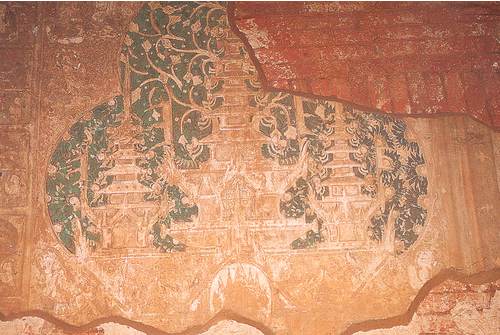ค้นหางานศิลปกรรม
ฐานข้อมูลศิลปกรรมในเอเชียตะวันออกเฉียงใต้
จิตรกรรมเขาพระสุเมรุ จิตรกรรมในเจดีย์โลกาเทียกพัน
ภาพเล่าเรื่องดังกล่าวแสดงรูปแบบตามแบบปาละอย่างมาก เช่น การใช้สีโทนร้อนเป็นหลัก ฯลฯ
จิตรกรรมสวรรค์ชั้นดาวดึงส์ จิตรกรรมในเจดีย์โลกาเทียกพัน
ภาพเล่าเรื่องดังกล่าวแสดงรูปแบบตามแบบปาละอย่างมาก เช่น การใช้สีโทนร้อนเป็นหลัก ฯลฯ อย่างไรก็ตาม ปยาทาดหรือปราสาทที่มีหลังคาลาดซ้อนกันหลายชั้นกลับเป็นลักษณะเฉพาะของพุกามเอง ปยาทาดนี้เป็นหลักฐานที่แสดงให้เห็นอาคารเครื่องไม้ในสมัยพุกามซึ่งปัจจุบันไม่หลงเหลืออยู่แล้ว
จิตรกรรมพระพุทธบาทบนเพดาน จิตรกรรมในเจดีย์โลกาเทียกพัน
ภาพเล่าเรื่องดังกล่าวแสดงรูปแบบตามแบบปาละอย่างมาก เช่น การใช้สีโทนร้อนเป็นหลัก ฯลฯ
จิตรกรรมพุทธประวัติ จิตรกรรมในเจดีย์ตโยกปเย
จิตรกรรมในเจดีย์ตโยกปยี เป็นตัวอย่างของจิตรกรรมในศิลปะพุกามตอนปลายที่มักเขียนภาพบุคคลขนาดใหญ่ พระพักตร์แสดงการ “ก้มลง” อย่างชัดเจน พื้นที่ว่างถูกถมไปด้วย “ลวดลายกนก” จำนวนมาก ทั้งหมดนี้แตกต่างไปจากศิลปะพุกามตอนต้น อย่างไรก็ตาม ขนบหลายประการ เช่นการเน้นสีโทนร้อน การเขียนต้นไม้แบบประดิษฐ์นั้นก็ยังคงดำเนินตามขนบปาละอยู่
จิตรกรรมปยาทาด จิตรกรรมในเจดีย์ตโยกปเย
จิตรกรรมในเจดีย์ตโยกปยี เป็นตัวอย่างของปยาทาด (ปราสาท) หรือเรือนที่มีหลังคาดซ้อนชั้นในศิลปะพุกามตอนปลายที่อาจสะท้อนให้เห็นว่ารูปแบบสถาปัตยกรรมของอาคารเครื่องไม้จริงในศิลปะพุกามที่สูญหายไปหมดสิ้นแล้ว ปราสาทถือเป็นเรือนฐานันดรสูงสำหรับพระพุทธเจ้าหรือกษัตริย์ ปรากฏมาตั้งแต่สมัยพุกามและยังคงปรากฏสืบทอดมาจนถึงสมัยมัณฑเล
จิตรกรรมการปราบช้างนาฬาคีรี จิตรกรรมในเจดีย์ปยาตองสู
จิตรกรรมแสดงการใช้โทนสีร้อนแบบปาละ คือ เน้นสีแดง เหลือง ดำ ขาว ส่วนรูปแบบของพระพุทธรูปล้วนแต่เกี่ยวข้องกับจิตรกรรมในใบลานของศิลปะปาละซึ่งคงถูกนำมาที่พุกามและกลายเป็นต้นแบบสำหรับจิตรกรพุกามด้วย อย่างไรก็ตาม การถมลวดลายลงไปในพื้นที่ว่างเปล่านั้นเป็นลักษณะที่นิยมในศิลปะพุกามตอนปลาย
จิตรกรรมลิงถวายบาตรน้ำผึ้ง จิตรกรรมในเจดีย์ปยาตองสู
จิตรกรรมแสดงการใช้โทนสีร้อนแบบปาละ คือ เน้นสีแดง เหลือง ดำ ขาว ส่วนรูปแบบของพระพุทธรูปล้วนแต่เกี่ยวข้องกับจิตรกรรมในใบลานของศิลปะปาละซึ่งคงถูกนำมาที่พุกามและกลายเป็นต้นแบบสำหรับจิตรกรพุกามด้วย อย่างไรก็ตาม การถมลวดลายลงไปในพื้นที่ว่างเปล่านั้นเป็นลักษณะที่นิยมในศิลปะพุกามตอนปลาย
จิตรกรรมจิตรกรรมประกอบซุ้มในเจดีย์ปยาตองสู
ซุ้มประตูของเจดีย์ปยาตองสูตกแต่งด้วยจิตรกรรมอย่างน่าสนใจ โดยตามเคล็กมีการถมด้วยลวดลายพันธ์พฤกษาแทนกลายเทวดาตามแบพุกามตอนปลาย ที่ปลายสุดของซุ้มปรากฏรูปกินนร-กินนรีกำลังยกมือไหว้ ซึ่งลวดลายนี้จะเป็นต้นแบบให้ศิลปะสุโขทัยและล้านนาในศิลปะไทย นอกจากนี้ยังประดับพระโพธิสัตว์กำลังกอดนางตาราอันแสดงแนวโน้มความเป็นมหายานของวัดแห่งนี้ได้เป็นอย่างดี


